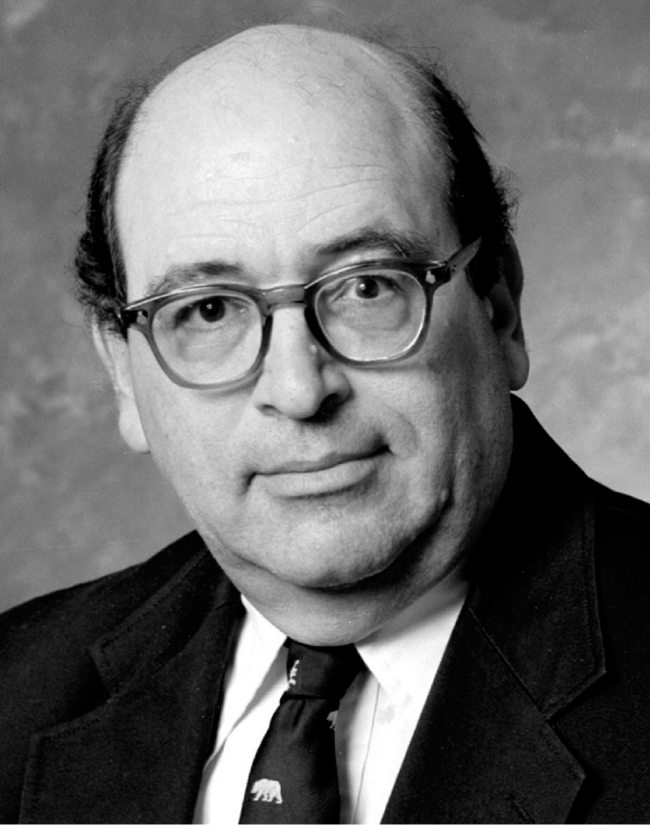Gilbert Shapiro
DOI: 10.1063/1.1564363
Gilbert Shapiro, a faculty member in the physics department of the University of California, Berkeley, for almost 40 years, died at his home in Moraga, California, on 5 December 2001. He first came to Berkeley in 1961 as a staff member at the Lawrence Radiation Laboratory (now Lawrence Berkeley National Laboratory) to engage in research in elementary particle physics. His interests and style fit well into the heady, exciting time for particle physics as old concepts were being overtaken by surprising new experimental results. His productive career came to an end while he was still vigorously active in teaching and research, when he succumbed to the cancer that had been first diagnosed two years earlier.
Shapiro was born 19 March 1934 in Philadelphia, Pennsylvania. Following his introduction to science at the Franklin Institute, he began its serious study at Central High School, a long-established Philadelphia public school with extraordinarily demanding entrance criteria. In 1955, having received a BA from the University of Pennsylvania, he started graduate study in physics at Columbia University.
At that time, Columbia was a leading institute for high-energy physics, and its Nevis Cyclotron Laboratory facility in the Hudson River valley north of New York City was the site of a number of major discoveries. Shapiro was naturally attracted there to pursue research in high-energy physics at Columbia. His PhD thesis advisers were Allan Sachs and Richard Garwin. Results based on his thesis, “Accurate Determination of the µ + Magnetic Moment,” were published in volume 2 of Physical Review Letters in 1959. Most important about that work was its determination of the vacuum dynamic contribution to the magnetic moment of the µ + particle, which had been predicted by quantum electrodynamics. He and Leon Lederman refined and expanded measurements of muon mass and magnetic moment in 1960 and 1961.
Upon his arrival in Berkeley, he joined Owen Chamberlain and Carson Jeffries to build the first polarized target for high-energy physics. Its initial use was in a pion–proton scattering experiment in 1963 at the Rad Lab’s 184-inch synchrocyclotron. The target was an application of the basic ideas of dynamic nuclear polarization that had been developed by Jeffries and independently by Anatole Abragam. During the following 15 years, Shapiro was a senior member of a research group that carried out numerous experiments with polarized targets at the synchrocyclotron and the Bevatron at the Rad Lab. Later, he continued that work at Fermi National Accelerator Laboratory and at SLAC. In 1965, he and his colleagues at Berkeley used the polarized-target technique to determine the intrinsic parity of strange particles. Afew years later at SLAC, he used it to search for evidence of time reversal invariance in the scattering of electrons. The polarized target work pioneered by Chamberlain and Shapiro at Berkeley spawned similar developments at nearly all the major high-energy physics facilities in the world, and a whole industry of polarized-target research soon evolved at accelerator facilities in England, France, Japan, the Soviet Union, and Switzerland.
In the 1980s, Shapiro worked with the Time Projection Chamber group that produced important results on high-energy electron–positron and photon–photon interactions at the SLAC storage ring SPEAR. The following decade, he joined the SLAC Large Detector group to determine the properties of the Z boson at the SLAC Linear Collider. This experiment also produced an accurate determination of the weak mixing angle, and thereby a sensitive test of the standard model. In another experiment at SLAC, he and collaborators studied deep-inelastic scattering of polarized electrons to obtain information on the spin structure of the neutron. His last research effort, begun in the late 1990s, was the planning of an imaginative use of cosmic-ray neutrinos to map Earth’s density through its mantle and core, in effect a computerized tomography scan of our planet.
Shapiro devoted most of his formal teaching efforts to sharing with a wide lay public his passion for physics and developing in them an appreciation for basic scientific fact and methodology. His characterization of the descriptive Physics 10 courses that he taught as “Physics for Football Players” indicates the kind of audience he wanted to reach. He penned Physics without Math (Prentice Hall, 1979) as a descriptive text for this kind of course. He followed that work with A Skeleton in the Darkroom: Stories of Serendipity in Science (Harper & Row, 1986), an entertaining account of serendipitous observations. He used that book as the basis for a freshman seminar he taught in the 1990s. Shapiro had no patience for charlatans and others who misinterpreted science, and he delighted in debunking false and misleading claims.
Shapiro savored simple California pleasures, most often with his family, to whom he was devoted. He enjoyed strolling through the redwoods at the Muir Woods National Monument near Mill Valley, California. A lover of classical music and an avid sports fan, he held season tickets for the opera, followed the local baseball and football teams, and attended World Cup soccer matches in the San Francisco Bay Area.
It was a pleasure to work with Shapiro. We miss his unpretentious personality, his deep insight into physics, and his willingness to help whenever he was asked.


More about the Authors
Owen Chamberlain. University of California, Berkeley, US .
William Chinowsky. University of California, Berkeley, US .
Herbert Steiner. University of California, Berkeley, US .




